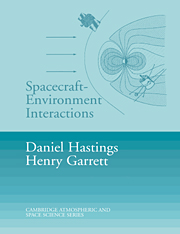Book contents
- Frontmatter
- Contents
- List of Illustrations
- List of Tables
- Preface
- Acknowledgment
- 1 Introduction
- 2 Fundamental Length, Time, and Velocity Scales
- 3 The Ambient Space Environment
- 4 Neutral Gas Interactions
- 5 Plasma Interactions
- 6 The Space Radiation Environment
- 7 Particulate Interactions
- 8 The State of the Art
- References
- Index
6 - The Space Radiation Environment
Published online by Cambridge University Press: 30 September 2009
- Frontmatter
- Contents
- List of Illustrations
- List of Tables
- Preface
- Acknowledgment
- 1 Introduction
- 2 Fundamental Length, Time, and Velocity Scales
- 3 The Ambient Space Environment
- 4 Neutral Gas Interactions
- 5 Plasma Interactions
- 6 The Space Radiation Environment
- 7 Particulate Interactions
- 8 The State of the Art
- References
- Index
Summary
Introduction
As electronic components have grown smaller in size and power and have increased in complexity, their enhanced sensitivity to the space radiation environment and its effects has become a major source of concern for the spacecraft engineer. The three primary considerations in the design of spacecraft are the description of the sources of space radiation, the determination of how that radiation propagates through material, and, thirdly, how radiation affects specific circuit components. As the natural and man-made space radiation environments were introduced in Chapter 3, the objective of this chapter is to address the latter two aspects of the radiation problem. In particular, because the “ambient” environment is typically only relevant to the outer surface of a space vehicle, it is necessary to treat the propagation of the external environment through the complex surrounding structures to the point inside the spacecraft where knowledge of the internal radiation environment is required. Although it is not possible to treat in detail all aspects of the problem of the radiation environment within a spacecraft, by dividing the problem into three parts – external environment, propagation, and internal environment – a basis for understanding the process of protecting a spacecraft from radiation will be established that can be applied to a wide range of radiation problems.
Radiation Interactions with Matter
From the standpoint of radiation interactions with matter, three particle families need to be considered:
photons (primarily EUV, X rays, and gamma rays),
charged particles (protons, electrons, and heavy ions),
neutrons.
Information
- Type
- Chapter
- Information
- Spacecraft-Environment Interactions , pp. 208 - 249Publisher: Cambridge University PressPrint publication year: 1996
Accessibility standard: Unknown
Why this information is here
This section outlines the accessibility features of this content - including support for screen readers, full keyboard navigation and high-contrast display options. This may not be relevant for you.Accessibility Information
- 1
- Cited by
